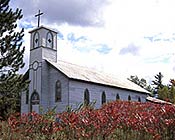
St. Joseph of the Lake Church is located on the Menominee Reservation in Wisconsin. It has played an important role in the continuation of Menominee traditions and was the community center for the South Branch Menominee. Catholic missionaries established a presence in this area by the last quarter of the 19th century. By 1888, the mission served 80 Menominee families and 12 European-American families from nearby towns.
Construction on the Church began in 1891, replacing an earlier building. Resources to build the church was provided by the South Branch Menominee, as was much of the construction work. The church was dedicated on June 17, 1893, while the cemetery (for Catholics) and burial ground (for non-Catholics) were established earlier around 1876. Bi-monthly services were conducted for many years, and services are still held here regularly.
The church also became a place for the preservation and continuation of traditional Menominee customs. The languages and ceremonies of many American Indian groups were lost as a result of their prohibition by governmental supervision on reservations. Menominee language and ceremonies were prohibited by the Superintendent of the Menominee reservation, specifically in the community of Keshena, where he lived. As Keshena was sixteen miles away from the South Branch community, this may have increased the number of traditional ceremonies held at St. Joseph of the Lake. The church then became the location for the South Branch Menominees’ pow-wows, dances to heal the sick and dying, wakes and funeral suppers, bean feasts and ghost suppers.
Wake singers were noted for singing in the Menominee language. Bean feasts are a blend of Catholic and Menominee customs, held annually on Three Kings Day (January 6). Wild game is served at a large communal feast, and a cake is shared in which one bean is embedded; the person who receives the slice containing the bean supports the feast the following year.
Ghost suppers were held the first year after a death, and were marked by a feast and prayers by the family to bring back the spirit of the dead.





